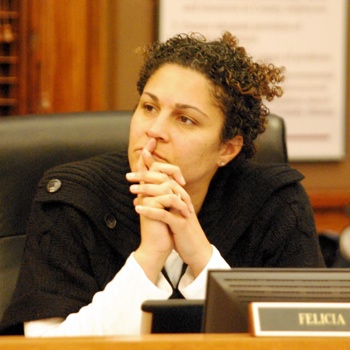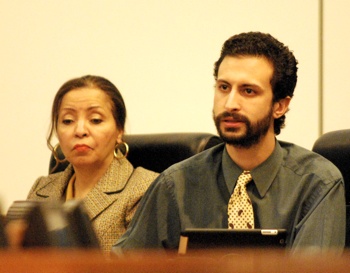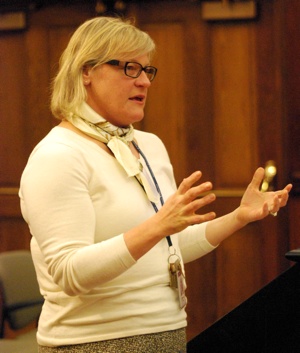County Board Briefed on Shelter Services
Washtenaw County board of commissioners working session (Feb. 6, 2014): Following a large turnout of homeless advocates at their Jan. 22, 2014 meeting, county commissioners received an update from the leader of the Shelter Association of Washtenaw County, which operates the Delonis Center shelter near downtown Ann Arbor.
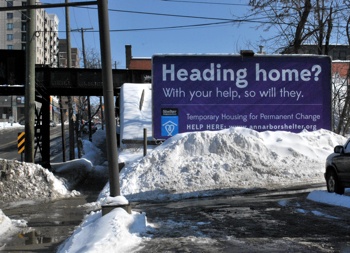
Billboard on West Huron, facing eastbound traffic, to seek support for the Shelter Association of Washtenaw County. The Delonis Center homeless shelter is located across the street. (Photos by the writer.)
Ellen Schulmeister, the Shelter Association’s executive director, called this season “The Winter of Great Effort,” with harsher weather and more demand for services. She described efforts to shelter the homeless in the short term, but noted that the broader goal is to find housing and provide support services to eliminate chronic homelessness.
Schulmeister reported that the county’s funding to the Delonis Center had been cut during the economic downturn, and she hoped that levels would increase. ”We need you to do that,” she said.
Washtenaw County government owns the building where the Delonis Center is located, and pays for maintenance. In addition, the county provided $51,230 for the Delonis Center in 2013 and increased that amount to $160,000 this year. The county funding is set to increase again to $200,000 in 2015 and remain at that level through 2017. The Shelter Association’s annual budget is $2.583 million.
Yousef Rabhi, chair of the county board, called the Delonis Center’s work ”inspirational,” but noted that the issue needs to be addressed by the entire community. He’s working to organize a summit, bringing together stakeholders from the government, nonprofits and other entities working to end homelessness. Rabhi said the effort should include representatives from the Ann Arbor District Library – because the downtown library serves as a de facto shelter during the day, even though that’s not the library’s purpose.
Schulmeister agreed on the importance of partnerships, adding that the barriers also include a lack of affordable housing and jobs. “It takes a community to house someone – it really does,” she said.
The Feb. 6 working session also included an update from Barbara Niess-May, executive director of SafeHouse Center, a shelter for survivors of domestic violence and sexual assault. As with the Delonis Center, the county also owns the SafeHouse building and pays for maintenance, as well as providing funding for the nonprofit’s services.
Niess-May told commissioners that she’s been doing this work for 20 years, but this is the worst time for funding she’s seen for these kinds of programs. She pointed out that funding from the county has dropped to $48,000 annually through 2017, and she hoped that the amount could be increased. The total SafeHouse budget is $1.4 million.
Dan Smith (R-District 2) noted that the number of people that SafeHouse serves each year – more than 5,000 – represents almost 2% of the county’s population. He highlighted the fact that Washtenaw County has fewer domestic violence homicides per capita than any other county in the state. To him, a statistic like that directly connects to the county’s mandates because of the clear reduction of work load on the court system and jail, as well as the number of lives saved. He considered SafeHouse part of the county’s mandate for public safety and justice.
Conan Smith (D-District 9) observed that the board has discussed the option of a human services millage that would support services like those that SafeHouse offers. He encouraged Niess-May to include the county’s funding cuts as part of her communications to others in the community. It might lead them to support raising additional revenue for SafeHouse and other organizations, he said.
Homeless Services
Andy LaBarre (D-District 7) began the presentation about homeless services by noting that at the board’s Jan. 22, 2014 meeting, several people attended to advocate for the homeless. He thanked Ellen Schulmeister, executive director of the Shelter Association of Washtenaw County, for attending the working session to give commissioners an update.
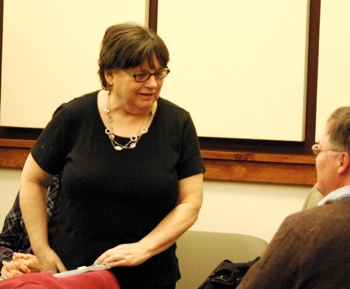
Ellen Schulmeister, executive director of the Shelter Association of Washtenaw County, talks with commissioner Kent Martinez-Kratz (D-District 1) at a Feb. 6 working session of the county board.
Schulmeister introduced the Shelter Association’s board president, Debbie Beuche, who also was on hand to answer questions. The winter has been rough, Schulmeister said, with the kind of weather that they haven’t seen for 20 years. She hoped it wouldn’t persist, but she’d heard that the next few winters are expected to be equally bad. “If that’s the case, we really have to figure out what we’re going to do.”
This kind of weather puts a huge focus on individuals who are homeless and out in the community. She knew there had been news reports and people talking directly to the board, and she wanted to clarify what the Shelter Association and the Delonis Center actually do.
The Delonis Center, located at 312 W. Huron in Ann Arbor, has been around for 10 years. It’s owned by the county and run by the nonprofit Shelter Association, under a subcontract with the Washtenaw Housing Alliance. The Delonis Center was built to house 50 beds, Schulmeister said, but there have been 75 beds since 2009.
The Shelter Association’s mission “to end homelessness one person at a time,” Schulmeister said. The association’s residential program is focused on working with people to get them into housing, she added, so that they leave the shelter successfully. The residential program has a success rate of over 50%. There are case managers working with 18 or fewer people at a time, in addition to mental health case managers, medical case managers, and a housing coordinator. They all work together with the goal of finding housing for people, she said. They focus on finding people income, and finding housing. Every year that the Delonis Center has been open, they’ve housed about 200 people annually.
Last year, given the demand for the shelter’s residential program, they added a “vulnerability screening” during intake to make sure that the most vulnerable people were getting into the shelter. As a result, that means it sometimes takes longer to move people out of the shelter and into housing, she explained, so there’s lower turnover.
In addition to the Shelter Association’s residential program, the Delonis Center building is used to provide services to as many people as possible, Schulmeister said, both residential and non-residential. So the services are available to people who are homeless – whether they are living in tents, or couch-surfing with friends and family, or living on the street. Anyone can walk in and sign up for services, including food, showers, laundry, help finding housing and jobs, and a variety of other services. In this way, the Shelter Association serves between 1,200 to 1,400 people each year, Schulmeister reported.
In fiscal 2012, 239 individuals were housed and services were provided to 1,262 people. In FY 2013, 190 people were housed, with services provided to 1,463 people. Year-to-date in FY 2014, 108 people have been housed and 1,081 people served. The Shelter Association also manages a housing voucher program through the U.S. Dept. of Housing and Urban Development (HUD) for about 40 people.
The non-residential homeless population is about double the size of the people in the Shelter Association’s residential program, Schulmeister said, “so we want to make sure that we are helping to keep people from freezing to death outside, because nobody deserves to do that, regardless of what their situation is.”
To help do that, a church rotating shelter provides sleeping space for up to 25 sober men. The men report to the Delonis Center, take a breathalyzer test, shower, have dinner at the shelter, then are picked up by churches to spend the night at a church. At 7 a.m. the next day, volunteers pick them up to take them to breakfast at St. Andrews.
In addition, the Delonis Center operates a warming center in its dining room, for a maximum of 65 people. The warming center is open from mid-November through March. There is no drug testing, but people are given a breathalyzer test and can’t get in if their blood alcohol level is over .10 – above the legal intoxication level of .08.
In the last few weeks because of the brutal weather, the warming center has had over 70 people, Schulmeister reported, and one night there were nearly 90 people. People are staying in the residential floors, in hallways, and in common rooms. The staff hasn’t turned anyone away due to being full, she said. They’re also encouraging people with high blood alcohol levels to go to the Home of New Vision’s engagement center or to the hospital to detox before they return. “We have not turned anybody away,” she said.
The center has relaxed its sobriety requirements, she added, and has allowed some people to stay there who are on the center’s “trespass list.”
Schulmeister told commissioners that the center is stretching its capacity, but that’s not unusual during bad weather. “It’s just that there’s been a lot,” she said.
The Delonis Center is intended to be a working place, Schulmeister said, where people were working to end their homelessness. Residents are allowed to be on the second floor, and non-residents are allowed to be there when they’re receiving services. “But they are not allowed to hang out at the shelter,” she said.
So one service that the Delonis Center doesn’t offer is a day shelter, where people can spend the day. “We don’t have that because we were asked not to have that,” she said.
However, whenever there’s bad weather – including freezing temperatures, snowstorms, thunderstorms, or tornadoes – the center allows people to come in and spend time during the day. The temperature in the winter for this “weather amnesty” is 10 degrees or less during the daytime, either wind chill or temperature. That’s when it starts to get dangerously cold, Schulmeister said. That number was based on the policy used by the Center for Homelessness in South Bend, Indiana, which served as a model when the Delonis Center was being built.
Last year, there were five weather amnesty days. So far this season, as of early February, there had been 35 weather amnesty days, Schulmeister reported. On those days, over 50 people have stayed in the dining room during the day – a couple of days, there were over 80 people, she said.
The staff is “pretty fried,” Schulmeister said, but that’s what happens in the winter. This has been an unusually bad season, she added. “My manager calls it The Winter of Great Effort, and that’s exactly what it is.”
The Shelter Association’s annual budget is $2.583 million. All government funding, including the federal housing voucher program, accounts for about 57% of the budget. County funding accounts for 6% of the budget, not including the building and maintenance. The coordinated funding allocation from the community comes from the city of Ann Arbor and United Way, not the county. The city’s funding accounts for 9% of the budget, with the United Way providing 3%.
The association also gets state funding, and some funds from the Federal Emergency Management Act (FEMA). There’s also funding for setting aside 10 beds for veterans.
All of that accounts for about $480,000. The remaining $2.103 million is raised from donations, foundation grants, and contributions from corporations. The board and the association’s development staff works hard to raise those funds, Schulmeister said. They focus a lot on major gifts, but also do mailings, fundraising events, and one-on-one solicitations. “It is gratifying to know that our community supports our shelter in the way that it does,” she told commissioners.
The association’s regular fundraising goal is around $955,000 but has been stretched to $1.1 million in order to prevent them from tapping reserves. Costs are increasing too, she noted. For example, Schulmeister said she’s happy that the Affordable Care Act is in place, but one result is that costs for the Shelter Association are increasing by at least $50,000.
A few years ago during the economic downturn, when the county board had to cut its budget, funding for the Shelter Association also was cut, Schulmeister noted. Some of that was restored for 2014, she added, and she hoped the board would restore more in coming years. “We need you to do that,” she said.
The county provided $51,230 to the Delonis Center in 2013 and increased that amount to $160,000 this year. The budget is set to increase again to $200,000 in 2015 and remain at that level through 2017.
Homeless Services: Board Discussion
Yousef Rabhi (D-District 8) told Schulmeister that the discussions in the community on this issue are good to have, “because we need to raise the profile that what is going on this winter is not unique to this winter. … We need to continue to fight for those that are homeless and those that are suffering through this winter right now.”
He noted that he participated in a great conversation recently with three clients of the Delonis Center warming shelter. Hearing their stories about trying to get back on their feet were eye-opening, he said. One was a teacher who got laid off during the bad economy. She had applied for a job as a substitute teacher, and had gone to apply with all of her belongings in her car. Because the employer could tell she was homeless, she wasn’t considered for the job, Rabhi said. Another client was a man with a minimum wage job who pays for a gym membership so that he can have a place to shower, Rabhi said. The man has to walk over a mile from the nearest bus stop to get to the gym in the morning, then walk back to take the bus to work.
“The barriers that are in place for the homeless are immense,” Rabhi said, telling Schulmeister that the work of the Delonis Center is “inspirational.”
Partnerships are at the core of being able to provide these services, Rabhi said, and such efforts need to be better coordinated. It’s been a while since there’s been a community discussion about how to support the homeless, he noted, and how to work on some of the barriers that exist.
He supported having a summit about homelessness. He also noted that the downtown library serves as a day warming shelter, even though that’s not its purpose. It’s important to have the Ann Arbor District Library director and a representative from the AADL board at the table in having these discussions, he said.
Schulmeister noted that the library serves this role all year round, not just during the winter. Having computers at the library is great, she said, because it’s an important resource for people. It provides access to information that people who are homeless wouldn’t otherwise have.
Schulmeister said the community conversation also needs to address the difficulty of housing people in Washtenaw County. There’s the “landlord factor,” she said, as well as issues with drugs, alcohol and mental illness. A lack of jobs is another issue, as well as someone’s felony background. Some people are working hard and are being helped by the Shelter Association, but still can’t find housing. “That is one of the saddest and worst things that we face. It takes a community to house someone – it really does.” It takes an employer who’s willing to take a chance, she said, and a landlord who’s willing to take a chance.
People who are homeless are a non-homogeneous population, Schulmeister said. Some people are working hard and take personal responsibility, and others don’t. Some people don’t want to spend their money on housing because it’s too expensive. They’ll choose not to be housed, and instead spend their money on other things. “Trying to give them better choices is what we have to strive for,” she said.
The barriers are reflected in the Delonis Center, because it becomes difficult to turn over the beds there. At that point, “we’re not a flow-through – we’re a collection agency,” Schulmeister said. “We’re just collecting people and keeping them there. That’s not useful for them or for us.”
Rabhi said it’s also important to address state and federal assistance, with cuts to food stamps and income tax credits. The barriers are becoming greater, he said, “because poor folks aren’t being prioritized any more.”
This community has all the pieces to help address this problem, Rabhi said, and it’s time to talk about taking the next steps.
Rabhi also pointed out that because of Washtenaw County’s services, people come here from other counties seeking help. So homelessness is a global issue that needs to be addressed in a global way. He hoped that Washtenaw County could coordinate with entities in nearby counties to address the issue regionally.
Schulmeister agreed. She noted that Detroit has shelters, but not enough to house all the homeless there. There aren’t any shelters in western Wayne County or Livingston County. There are some shelters in Monroe County, but those are mostly focused on families. “There just is not enough supply for the demand,” she said. “And even if we got everyone into a shelter, then what?”
SafeHouse Center
The Feb. 6 working session also included a presentation from Barbara Niess-May, executive director for the SafeHouse Center. She briefed the board on the status of this nonprofit, which provides support services and shelter for survivors of domestic violence and sexual assault.
The center serves over 5,000 women, children and some men each year. While the center is probably best known for its shelter services, she said, they also provide legal advocacy, 24/7 response, support groups, counseling, and prevention/awareness activities.
She told commissioners that she’s been doing this work for 20 years, but this is the worst time for funding she’s seen for these kinds of programs. In the mid-1990s, the federal government prioritized funding for these programs to make our communities safer, she said. In Michigan, about 100 women die each year because of intimate-partner homicide, and half of those are murder suicides, she noted. “It wracks communities for decades.”
If commissioners were wondering why they don’t hear about this kind of violence in Washtenaw County, she said, it’s because SafeHouse partners with law enforcement. “Because of the work that SafeHouse Center does, we are a safe community,” she said, with fewer domestic violence homicides per capita than any other county in the state.
She had come to the board because of funding losses that SafeHouse has experienced. The center has lost about 10% of its budget. The SafeHouse shelter budget alone is about $300,000 per year. The U.S. Dept. of Housing & Urban Development (HUD) cut $100,000 in funding for SafeHouse’s shelter budget, she said – a third of the shelter’s operation budget. That supports about 300 women and children each year.
Niess-May said that earlier in the evening she had a SafeHouse board meeting and told the board that if they can’t raise $100,000, they’d have to make changes in operations.
She said some people might wonder why SafeHouse isn’t publicizing its financial situation. “The primary reason is because I don’t want survivors to think that there isn’t a place to go. It’s not safe for me to start ringing the cow bell and saying we are in big trouble.” The last thing she wants is for some assailant to tell a survivor that they don’t have the option of going to SafeHouse because of budget cuts, she said.
SafeHouse staff, board and volunteers are taking their fundraising effort very seriously, Niess-May told commissioners. In the first quarter of their current fiscal year, SafeHouse raised more money than they’d ever raised before – yet still fell short of its first-quarter goal by $35,000, she said. Niess-May added that she’s worried about sustainability, because funders aren’t providing long-term commitments.
About 12 years ago, she told commissioners, the county approached SafeHouse and asked the nonprofit to support sexual assault survivors in this community. SafeHouse took on that role, under the assumption that it would be revenue-neutral. At that time, SafeHouse received an annual grant of $120,000 for those services. Now, funding from the county is $48,000 a year. Her understanding is that the county’s four-year budget from 2014-2017 keeps funding at that same level. “That concerns me, and I felt strongly about sharing that in this forum.”
SafeHouse is in a really difficult situation, she said. They had to add almost $200,000 to the nonprofit’s fundraising goal, which was about a 50% increase from last year to this year, she said. “I am hopeful that the county can help us at some point.” She said she deeply appreciates the county’s support and partnership, saying it’s made a tremendous difference in the lives of survivors.
SafeHouse Center: Board Discussion
Dan Smith (R-District 2) noted that the number of people served by SafeHouse each year – more than 5,000 – represents almost 2% of the county’s population. He was also impressed with Niess-May’s report that Washtenaw County had the lowest per capita number of domestic violence homicides in the state. He noted that the board often talks about its mandates for providing services. To him, a statistic like that directly connects to the county’s mandates because of the clear reduction of work on the court system and jail, as well as the number of lives saved. He thanked Niess-May for her work and presentation to the board.
Niess-May said this work is done with 23 staff members and 150 active volunteers who provide 15,000 hours of service every year. SafeHouse is trying to leverage every resource as creatively as they can, she said.
Conan Smith (D-District 9) said everyone needs to be aware that the county has cut funding to SafeHouse, and that there are consequences to their investment decisions. In general, Smith said the public trusts county government, so a lot of people probably assume that the county is helping in the way that it always has. “They need to know we’re not,” he said. The resources haven’t been there to support SafeHouse, he added, while the need has increased.
C. Smith noted that the board has discussed the option of a human services millage that would support services like those that SafeHouse offers. He encouraged Niess-May to include the county’s funding cuts as part of her communications to others in the community. It might lead them to support raising additional revenue for SafeHouse and other organizations, he said.
Niess-May noted that over the last 10 years, SafeHouse has seen over $1 million in total funding cuts.
Yousef Rabhi (D-District 8) thanked Niess-May for her work, and said the community is fortunate to have an organization like SafeHouse that stands up for people who need help. He noted that he wanted to understand SafeHouse’s situation, noting that financial strain is coming from multiple sources.
He clarified with Niess-May that the $300,000 budget she’d mentioned in her presentation is only for the shelter portion of the operations. The entire SafeHouse budget is $1.4 million, she reported. The county’s line item of $48,000 includes a small portion for the shelter, but most of it is for support services.
In addition to the $100,000 in cuts from HUD, other cuts mentioned by Niess-May include:
- $7,633 cut in funds from the Victims of Crime Act, which resulted in eliminating SafeHouse’s translation services for survivors who don’t speak English, as well as professional development for staff and staff mileage reimbursement.
- $7,000 cut from the city of Ann Arbor’s Grant to Encourage Arrest Policy funding, which resulted in a loss of salary and support expenses for legal advocacy.
- $3,600 cut in Legal Assistance to Victims funding, which also resulted in less support for legal advocacy.
Niess-May also cited higher expenses, including health insurance and keeping up with the city of Ann Arbor’s living wage. In total, all of this has created a budget gap of about $200,000. As a result, SafeHouse has raised its fundraising goal from $400,000 to $600,000.
Rabhi asked what the consequences would be if SafeHouse doesn’t raise the additional $200,000. Niess-May replied that she couldn’t speak for her board, because in the end it would be a policy decision. But the options that staff have looked at include closing rooms at the shelter, and reducing response to calls from law enforcement. “We’re running lean,” she said.
Rabhi asked Niess-May to explain the full extent of the county’s support, in addition to the $48,000 line item. SafeHouse also gets about $100,000 from the coordinated funding process. Those funds are awarded through a competitive application in which several funding agencies participate – including the county, city of Ann Arbor, and United Way of Washtenaw County.
County administrator Verna McDaniel also noted that the county owns the building where SafeHouse is located. SafeHouse pays rent and utilities, but the county pays for upkeep on the facility.
In response to a query from Andy LaBarre (D-District 7), Niess-May reported that when the facility was built, the understanding was that SafeHouse would be providing residential and non-residential services to survivors of domestic violence. That’s in the language of the lease, she said, and was in the ballot language for the bond that’s paying for the building, which voters approved in 1992. Later, about 12 years ago, the county also asked SafeHouse to also provide services for survivors of sexual assault.
Dan Smith, responding to a comment earlier in the discussion about a possible human services millage, said he didn’t consider SafeHouse as a human services provider. Rather, he considered it part of the county’s mandate for public safety and justice.
Felicia Brabec (D-District 4) praised SafeHouse, and noted that residents had approved the bond to pay for the building. That reflects the fact that this is a community value, she said, and it’s important to keep that in mind. Brabec agreed with Dan Smith that SafeHouse provides public safety services, but she also felt that it fit into human services as well. In terms of the county budget, SafeHouse touches on many of the community impacts that the county is trying to address. “We have the opportunity to impact and change lives,” Brabec said.
Niess-May said she was sensing an undercurrent that she’d stay away from, but she noted that Washtenaw County is the only county in the state where an organization like SafeHouse has partnered with every law enforcement agency in the county. Whenever there’s a domestic violence or sexual assault call in the county – and there are about 2,000 every year – the law enforcement agencies call SafeHouse. Of those, 1,700 are for domestic violence, she said, resulting in 250 people who get convicted. “So the rest of them are still out there.”
“Most men are good men,” Niess-May added. “Ninety percent are good men. It’s the 10 percent that offend and keep re-offending.”
Washtenaw County and SafeHouse have a model that’s unique in the state, she concluded. “And it’s paying off in huge dividends.”
Addressing Niess-May’s comment about an undercurrent in the discussion, LaBarre noted that it’s far easier to make the case to fund public safety. “You don’t theoretically need human services if you’re dead,” he said. So commissioners are considering how to think about SafeHouse in that context.
Present: Felicia Brabec, Andy LaBarre, Kent Martinez-Kratz, Yousef Rabhi, Conan Smith, Dan Smith.
Absent: Alicia Ping, Ronnie Peterson, Rolland Sizemore Jr.
Next regular board meeting: Wednesday, Feb. 19, 2014 at 6:30 p.m. at the county administration building, 220 N. Main St. in Ann Arbor. The ways & means committee meets first, followed immediately by the regular board meeting. [Check Chronicle event listings to confirm date.] (Though the agenda states that the regular board meeting begins at 6:45 p.m., it usually starts much later – times vary depending on what’s on the agenda.) Public commentary is held at the beginning of each meeting, and no advance sign-up is required.
The Chronicle could not survive without regular voluntary subscriptions to support our coverage of public bodies like the Washtenaw County board of commissioners. Click this link for details: Subscribe to The Chronicle. And if you’re already supporting us, please encourage your friends, neighbors and colleagues to help support The Chronicle, too!





